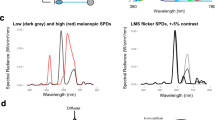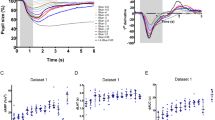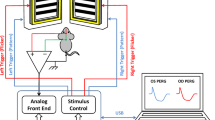Abstract
THE role of pigment migration in light–dark adaptation of the eyes of nocturnal moths has long interested investigators1,2. Efforts have been made to find out what part pigment migration plays in the behavioural changes associated with light–dark adaptation3, and in the phenomenon called ‘glow’4. Recently, it has been reported that adaptation in nocturnal moths occurs in two stages, the first of which is not accompanied by pigment migration5. The discovery that variations can occur in the light-threshold of a dark-adapted compound eye with practically no change in the glow area6 is further evidence of the independence of adaptation and pigment position.
This is a preview of subscription content, access via your institution
Access options
Subscribe to this journal
Receive 51 print issues and online access
$199.00 per year
only $3.90 per issue
Buy this article
- Purchase on Springer Link
- Instant access to full article PDF
Prices may be subject to local taxes which are calculated during checkout
Similar content being viewed by others
References
Exner, S., Deuticke (Leipzig and Wien, 1891).
Tuurala, O., Ann. Acad. Sci. Fenn., Ser. A, 24, 1 (1954).
Collins, D. L., J. Exp. Zool., 69, 165 (1934).
Day, M. F., Biol. Bull., 80, 275 (1941).
Bernhard, C. G., and Ottoson, D., J. Gen. Physiol., 44, 195, 205 (1960).
Höglund, G., Life Sciences, No. 4, 275 (Pergamon Press, 1963).
Author information
Authors and Affiliations
Rights and permissions
About this article
Cite this article
EDWARDS, D. Light–dark Adaptation, and ‘Glow’, in Abnormal Moth Eyes without Pigment. Nature 202, 621–622 (1964). https://doi.org/10.1038/202621a0
Issue Date:
DOI: https://doi.org/10.1038/202621a0
This article is cited by
-
Heat transfer in turbulent flow with radiation for small optical depths
Applied Scientific Research (1970)
Comments
By submitting a comment you agree to abide by our Terms and Community Guidelines. If you find something abusive or that does not comply with our terms or guidelines please flag it as inappropriate.



